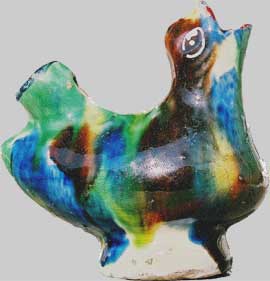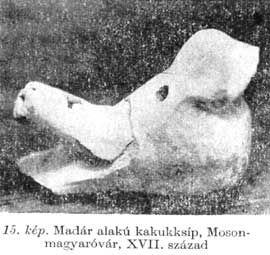| |
Discovery context:
Visiting flea markets in the villages during your holidays, there's a strong chance that you find such a whistle. This one was bought 1€ (1$) in a flea market in Normandy.
Even if it has no historical interest, it seems usefull to precise its origin because those whistles can be sold in France as antique earthenware whistles from Provence or, in England, as Staffordshire pottery. Of course, the sellers presents them as Victorian or even 18th C. and the prices are in accordance with this age.
General description:
It is a bird whistle. The bird has a large socle. It has its head up and an opened beak.
The whistle is on the top ahead of the tail.
The general state is good. The glaze has small chips.
The clay is light and heavy
|

 
L : 8,1 cm
H : 8,1 cm
l : 4,8 cm |
|
| |
The decoration:
The whistle has a blue, brown and green glaze. The variety of glazes for such whistles is infinite. You can see other ones clicking on the arrows below. Some whistles are slip pottery. The eyes are painted in white and the beak in red. Usualy, those whistles have floral hand painted patterns.
The paint quality is poor so those paintings are frequently erased.
|
|
| |
Those whistles are made in Romania in the potter center of Corund. They are moulded then hand-painted.
Some of them are dated. Those dates are not older than the 70s and the production still existed near 2000. We were unable to find in the bibliography when this production begun.
The shape is far from the traditional Romanian whistles bovid or goat shaped made in Pisc. It is normal because Corund,even if in Romania, is in the Hungarian region of this country.
Thus similar old shapes must be searched in Hungary.
The searcher Péter Király presents in his study of the Hungarian whistles from the 15 to the 18th century bird whistles dated of the 17th C. where the whistle is inserted like our modern whistles at the top ahead of the tail
Those whistles have no base but other globular whistles of the 16th C are bird shaped with a socle.
This shape is effectively a traditional Hunrarian one.
| 
Hungarian whistle. 17th C.
P Kiraly. Etnographia XCVI 1985 Budapest.Hanzagi Museum |
|